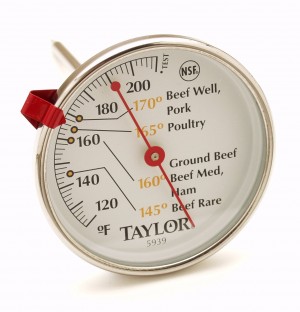 Even seasoned cooks who depend regularly and almost instinctively on their sense of sight, smell, sound, and feel to gauge degree of doneness in foods, also depend on a temperature guide and a thermometer. Sometimes the cook is fooled by a lovely brown crust that hides a doughy interior or a custard that seems too thin, yet is sending forth contradictory signals of overcooking. In these and dozens of other instances, using a thermometer makes perfect sense.
Even seasoned cooks who depend regularly and almost instinctively on their sense of sight, smell, sound, and feel to gauge degree of doneness in foods, also depend on a temperature guide and a thermometer. Sometimes the cook is fooled by a lovely brown crust that hides a doughy interior or a custard that seems too thin, yet is sending forth contradictory signals of overcooking. In these and dozens of other instances, using a thermometer makes perfect sense.
Every kitchen should have two thermometers. The first is an instant-read thermometer with a thin probe that registers accurately within 10 seconds of insertion. It usually reads between 40º and 260º Fahrenheit, which is useful for many things, from measuring the temperature of water intended for dissolving yeast to the temperature of a pot roast. The second is a deep fry/candy thermometer. The temperature reads from 200º to 400º Fahrenheit and is perfect for testing hot oil and sugar syrups.
Armed with these two tools, the following guide to temperature should get you cooking to the right degree.
Testing Your Thermometer’s Accuracy
Test your thermometer’s accuracy by placing it in boiling water. At sea level, it should read 212°F. If it reads above or below 212°F, make the necessary recalibration when testing a food’s temperature.
Converting Fahrenheit Degrees to Celsius/Centigrade Degrees
If you need to convert Fahrenheit degrees to Celsius/Centigrade degrees, subtract 32, multiply by 5, and divide by 9. To convert Celsius/Centigrade degrees to Fahrenheit degrees, multiply by 9, divide by 5, and add 32. Oh heck, just go to this online calculator.
General Temperatures
5º-10º Cream gains this much heat when whipped with unchilled beater and bowl
5º-15º Degrees roast will increase by after removal from the oven
20º The minimum temperature at which frozen foods should be stored
29º Egg freezing point
30º Best egg storage temperature
32º-40º Normal refrigerator temperature
36º Eggs straight from the refrigerator
40º-140º Danger zone for bacterial growth
50º Minimum temperature for keeping crabs and lobster alive
60º-125º Bacterial growth danger zone
60º-100º The flavors of salt, sweet, and bitter are best perceived
80º-95º Yeast is liveliest in this temperature range
140º Yeast dies at this temperature
145º-161º Temperatures for pasteurizing milk
149º Egg whites coagulate
156º Egg yolks coagulate
160º-170º Ideal temperature for hollandaise when making
175º Alcohol boiling point
180º Water temperature for melting gelatin
180º Ideal temperature for cooked custards; go no higher
180º Maximum temperature for milk or half & half enriched soups without flour
185º Bread is done
185º-205º Best coffee brewing temperature
Meat Temperatures
135º Rare beef
140º Desired temperature for ready-to-eat ham
145º Medium-rare beef
145º-150º Medium-rare lamb
180º-185º Preferred by some cooks as desired temperature for cooked pork
150º Minimum degree for pork, allowing a 13º safety margin for killing trichinae
160º USDA-approved temperature for medium pork (not considered safe below 160º)
160º USDA-approved temperature for ground beef (not considered safe below 160º)
160º-165º Well-done lamb
165º-170º Safely cooked pork; my temperature preference
165º USDA-approved minimum safe temperature for cooked poultry.
175º-180º Cooked chicken; French temperature preference
190º Cooked chicken; American temperature preference
Fish Temperatures
110º-120º Cooked saltwater fish
120º Cooked freshwater fish (to kill parasites)
180º Water temperature for poaching fish
375º Temperature for pan frying fish
450º Best temperature for broiling fish
Oven Temperatures
200º-250º Very slow, very cool, or warm
250º-300º Slow or cool
300º-350º Very moderate
350º-375º Moderate
375º-400º Moderately hot to hot
425º-450º Hot to very hot
450º-500º Very hot
550º Most broiler temperatures
1000º Self-cleaning oven temperature when cleaning
Stove-Top Temperatures
195º Low simmer
210º High simmer
212º Boiling water at sea level; light or vigorous boil
213º-214º Boiling temperature of salted or sugared water; 1 teaspoon per quart
250º Maximum pressure cooker temperature
250º Butter smoke point
300º For seasoning lightly oil-coated pans in the oven
325º Water drops dance on skillet surface
325º Black pepper burning point
350º Clarified butter smoke point
Sugar Syrup Temperatures
230º-234º Thread
234º-238º Soft ball
238º-244º Medium ball
244º-248º Firm ball
248º-254º Hard ball
254º-265º Very hard ball
265º-285º Light crack
290º-300º Hard crack
340º Caramel
Chocolate Temperatures
51° Gamma (type I) crystals start to form
69° Alpha (type II) crystals start to form
78° Beta prime (type III and IV) crystals start to form
84° Cool melted chocolate for tempering
85° Beta (type V) crystals start to form
85°-87° Melt chocolate for tempering
88° Beta (type V) crystals melt
115° Chocolate may scorch
125° Chocolate burns
Smoke Points
375º Olive oil
375º Vegetable shortening
420º Sesame oil
440º Peanut oil
475º Corn oil
495º Soybean oil
510º Safflower oil
600º Flash point of most oils
700º Fire point of most oils
550º Most broiler temperatures
Cookin’ with Gas (inspiration from around the web)
- How Temperatures Affect Food | USDA
- Safe Minimum Cooking Temperatures | Food Safety
- USDA Safe Food Chart | USDA
Copyright 2000-2017 Susan S. Bradley. All rights reserved.
